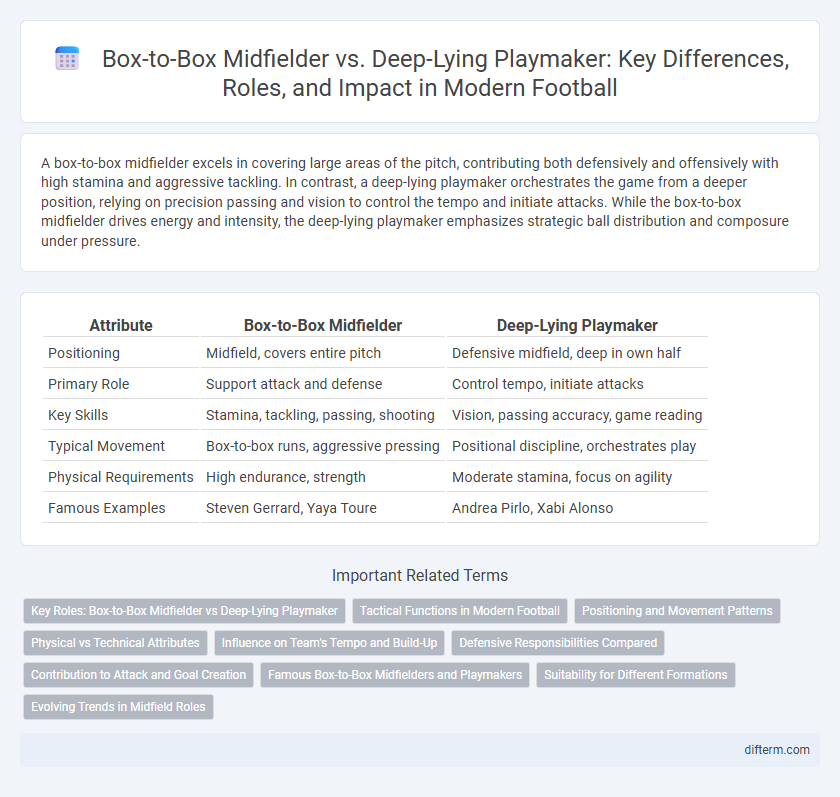A box-to-box midfielder excels in covering large areas of the pitch, contributing both defensively and offensively with high stamina and aggressive tackling. In contrast, a deep-lying playmaker orchestrates the game from a deeper position, relying on precision passing and vision to control the tempo and initiate attacks. While the box-to-box midfielder drives energy and intensity, the deep-lying playmaker emphasizes strategic ball distribution and composure under pressure.
Table of Comparison
| Attribute | Box-to-Box Midfielder | Deep-Lying Playmaker |
|---|---|---|
| Positioning | Midfield, covers entire pitch | Defensive midfield, deep in own half |
| Primary Role | Support attack and defense | Control tempo, initiate attacks |
| Key Skills | Stamina, tackling, passing, shooting | Vision, passing accuracy, game reading |
| Typical Movement | Box-to-box runs, aggressive pressing | Positional discipline, orchestrates play |
| Physical Requirements | High endurance, strength | Moderate stamina, focus on agility |
| Famous Examples | Steven Gerrard, Yaya Toure | Andrea Pirlo, Xabi Alonso |
Key Roles: Box-to-Box Midfielder vs Deep-Lying Playmaker
A box-to-box midfielder excels in covering large areas of the pitch, contributing both defensively and offensively by supporting attacks and tracking back to regain possession. The deep-lying playmaker primarily operates from a deeper position, dictating the tempo, distributing precise passes, and orchestrating play from the back. Key roles contrast as the box-to-box midfielder emphasizes stamina and versatility, while the deep-lying playmaker focuses on vision, passing accuracy, and strategic positioning.
Tactical Functions in Modern Football
Box-to-box midfielders exhibit dynamic versatility by contributing both defensively and offensively, covering extensive ground to support transitions and maintain team structure. Deep-lying playmakers operate from a deeper position, orchestrating play through precise passing and vision to control tempo and initiate attacks. Tactical functions in modern football demand balancing stamina, positional awareness, and ball distribution to maximize midfield effectiveness.
Positioning and Movement Patterns
Box-to-box midfielders exhibit dynamic positioning, frequently transitioning between defensive and attacking zones to support both ends of the pitch, making continuous, high-intensity runs that span the length of the field. In contrast, deep-lying playmakers maintain a more static position, operating predominantly near the defensive midfield area to orchestrate play through precise passing and strategic ball distribution. While box-to-box players rely on stamina and versatility in movement patterns, deep-lying playmakers emphasize spatial awareness and timing to influence the game's tempo from deeper positions.
Physical vs Technical Attributes
A box-to-box midfielder excels in stamina, speed, and physicality, covering large areas of the pitch to support both defense and attack. In contrast, a deep-lying playmaker relies on superior technical skills such as precise passing, vision, and game intelligence to control the tempo and distribute the ball effectively from a deeper position. The physical demands emphasize endurance and aggression for the box-to-box role, while the deep-lying playmaker prioritizes creativity and tactical awareness.
Influence on Team's Tempo and Build-Up
A box-to-box midfielder drives the team's tempo by continuously transitioning between defense and attack, applying pressure and creating scoring opportunities through dynamic movement. In contrast, a deep-lying playmaker dictates the build-up from a deeper position, using precise passing and vision to control the game's rhythm and distribute the ball strategically. Both roles influence team dynamics differently--box-to-box midfielders energize and escalate play, while deep-lying playmakers orchestrate and stabilize ball progression.
Defensive Responsibilities Compared
Box-to-box midfielders engage actively in both defensive and offensive phases, frequently intercepting passes, making tackles, and tracking back to shield the defense. Deep-lying playmakers primarily focus on positional awareness and orchestrating build-up play from deeper areas, relying more on tactical intelligence than on physical interceptions or tackles. Defensive responsibilities for box-to-box midfielders emphasize dynamic ball recovery and pressing, while deep-lying playmakers prioritize maintaining defensive shape and initiating counterattacks.
Contribution to Attack and Goal Creation
A box-to-box midfielder excels in both defensive and offensive transitions, frequently joining attacks with late runs into the penalty area and contributing with key passes and goals. In contrast, a deep-lying playmaker primarily orchestrates play from a deeper position, focusing on precise long-range passing and controlling the tempo to create goal-scoring opportunities for forwards. While the box-to-box midfielder provides dynamic goal threat and forward momentum, the deep-lying playmaker enhances attack through vision and strategic distribution.
Famous Box-to-Box Midfielders and Playmakers
Famous box-to-box midfielders like Steven Gerrard and Frank Lampard are renowned for their relentless energy, stamina, and versatility in both defense and attack, covering large areas of the pitch. In contrast, iconic deep-lying playmakers such as Andrea Pirlo and Xavi Hernandez excel in dictating the tempo of the game with precise passing, vision, and positional awareness from deeper roles. These distinct roles highlight the strategic diversity in midfield dynamics essential for team balance in football.
Suitability for Different Formations
Box-to-box midfielders excel in formations like 4-3-3 or 4-4-2 that demand dynamic transitions between defense and attack, covering extensive ground to support both phases effectively. Deep-lying playmakers thrive in systems such as 3-5-2 or 4-2-3-1, where their vision and precise passing enable control of tempo from a deeper position, providing defensive stability and orchestrating build-up play. Choosing between these roles depends on tactical emphasis: high-pressing, fast-breaking teams benefit from box-to-box energy, while possession-based setups gain from the strategic distribution of deep-lying playmakers.
Evolving Trends in Midfield Roles
Box-to-box midfielders are characterized by their stamina and versatility, contributing significantly to both defensive recovery and offensive support, shaping modern pressing systems. Deep-lying playmakers prioritize vision and precise distribution from deeper positions, orchestrating play and controlling tempo with a strategic focus on ball retention. Recent tactical trends emphasize hybrid midfielders who combine dynamic box-to-box runs with deep-lying playmaker intelligence, reflecting evolving demands for flexibility and multifunctionality in midfield roles.
Box-to-box midfielder vs deep-lying playmaker Infographic

 difterm.com
difterm.com